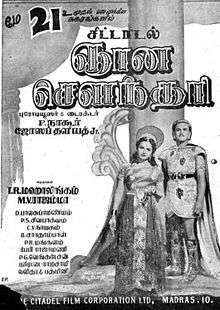Gnana Soundari
| Gnana Soundari | |
|---|---|
 Theatrical Release Poster | |
| Directed by |
F. Nagoor, Joseph Thaliath Jr. |
| Produced by |
F. Nagoor, Joseph Thaliath Jr. |
| Screenplay by | Nanjilnadu T. N. Rajappa |
| Story by |
F. Nagoor, Joseph Thaliath Jr. |
| Starring |
T. R. Mahalingam D. Balasubramaniam M. V. Rajamma P. S. Sivabhagyam |
| Music by | S. V. Venkatraman |
| Cinematography | Jithin Banerjee, Selvaraj |
| Edited by | VB Natraj |
Release dates |
|
Running time | 183 minutes[1] |
| Language | Tamil |
Gnana Soundari is a 1948 Indian Tamil language historical fiction film written, produced and directed by the duo F. Nagoor and Joseph Thaliath Jr. The film stars T. R. Mahalingam, M. V. Rajamma in lead roles with D. Balasubramaniam, Sivabhagyam, Lalitha and Padmini playing supporting roles. The film revolves around Gnana Soundari, daughter of King Dharmar who is ill-treated by her stepmother Lenal. In order to get rid of her, Lenal sends her to a forest. In the process, Soundari loses both of her hands and she gets saved by prince Pilenthiran.
The film was adapted from a stage play conducted by Nawab Rajamanickam which itself adapted from a Christian folk tale. The film's screenplay was written by Nanjil Nadu T. N. Rajappa. The film's soundtrack was composed by S. V. Venkatraman. Jithin Banerjee and Selvaraj handled the film's cinematography respectively. The film was edited by V. B. Nagaraj. Gnana Soundari was made with an estimated budget of ₹30,000 with a final film reel length of 5,264 metres (17,270 ft). Development of the film began when Citadel Pictures decided to adapt the film while S. S. Vasan directing another version of same play at that time. The film was released on 21 May 1948 with this version being successful while the version of Vasan failed.
Cast
- T. R. Mahalingam as Pillenthiran
- M. V. Rajamma as Gnanasoundari
- D. Balasubramaniam as Dharmar
- Sivabhagyam as Lenal
Production
F. Nagoor and Joseph Thaliath Jr., son of judicial officer in Trivandrum decided to produce and direct the film based on a stage play conducted by Nawab Rajamanickam which itself adapted from a Christian folk tale.[lower-alpha 1][2][3] During the same time, S. S. Vasan announced making the film adaptation of same stage play for which he had cast M. K. Radha and Kannamba in lead roles.[4] SV Venkatraman composed the film's music and Jithin Banerjee and Selvaraj were the film's cinematographers.[1] The film was edited by Nagaraj while Nagoor was the film's art director. The film's screenplay was written by Nanjil Nadu and T. N. Rajappa.[1] The producers had originally chosen Bhanumathi for the titular character. However she opted out as she felt uncomfortable shooting with her hands being tied back for many scenes.[4] Kannada actress M. V. Rajamma was chosen for the role.[2] Makeup man Haribabu made her look young as she was elder than TR Mahalingam.[4] To develop the scenes of lead character struggling in forest, makers watched a Hollywood film on Jesus christ and developed the scenes by getting inspired from the film.[lower-alpha 2] [4] The film was made on a budget of estimated budget of ₹30,000 with Rajamma being paid ₹1500 and Mahalingam being paid ₹5000 with additional amount of 2500.[4] It became the first Tamil film where a song sequence presented the life of Christ on screen.[5]
Themes and influences
General Pictures Corporation, pioneers of silent cinema in the South, produced a silent film titled `Gnanasundari' directed by A. Narayanan in 1929, the same story was filmed in Tamil by Sreenivasa Cinetone again directed by A. Narayanan with Sreenivasa Rao and Sarojini in lead roles.[6] The film was a huge success. The Malayalam version which was released on 22 December 1961 was a faithful copy of the 1948 version. Though the story and script by Muttathu Varkey was based on a novel of the same title authored by him, the dialogues closely resembled that written by Nanjil T.N. Rajappa for the Tamil version.[6] Except for the hero and the heroine, the names of the other characters were changed in the Malayalam film. The Malayalam version was a success, but not as successful as the Tamil original.[6]
Soundtrack
The film's soundtrack was composed by S. V. Venkatraman and were written by Kambadasan. The song "Arultharum Devamatha" was well received and it is a cult classic. The song was sung by Periyanayaki and young Jikki.[7]
Release
Joseph Thaliath Jr. had to release the film on his own at Paragon theatre as part of sharing revenue basis since no distributor were willing to buy the film as they felt Vasan's version was larger in appeal. However the film of Vasan failed at box office as audience could not accept characters speaking in a Brahmin accent and this version was well received at box office. S. S. Vasan, withdrew his film from the theatres as a respect to the tremendous victory of the Citadel version.[6] Distributors who initially backed off asked for the film's distribution rights. Producers sold all the areas with a hefty amount and gained profit through which they built "Citadel Studios".[4]
Notes
References
- 1 2 3 4 Dhananjayan 2014, p. 76.
- 1 2 "Gnanasoundari 1948". The Hindu.
- ↑ randor guy. "Ithaya Geetham (1950)". The Hindu.
- 1 2 3 4 5 6 Dhananjayan 2014, p. 77.
- ↑ B. VIJAYAKUMAR. "Jesus: 1973". The Hindu.
- 1 2 3 4 "GNANASUNDARI 1961". The Hindu.
- ↑ "The Hindu : Her tantalising voice will live forever ...". thehindu.com.
Bibliography
- Dhananjayan, G. (2014). Pride of Tamil Cinema: 1931 to 2013. Blue Ocean Publishers. ISBN 978-93-84301-05-7.